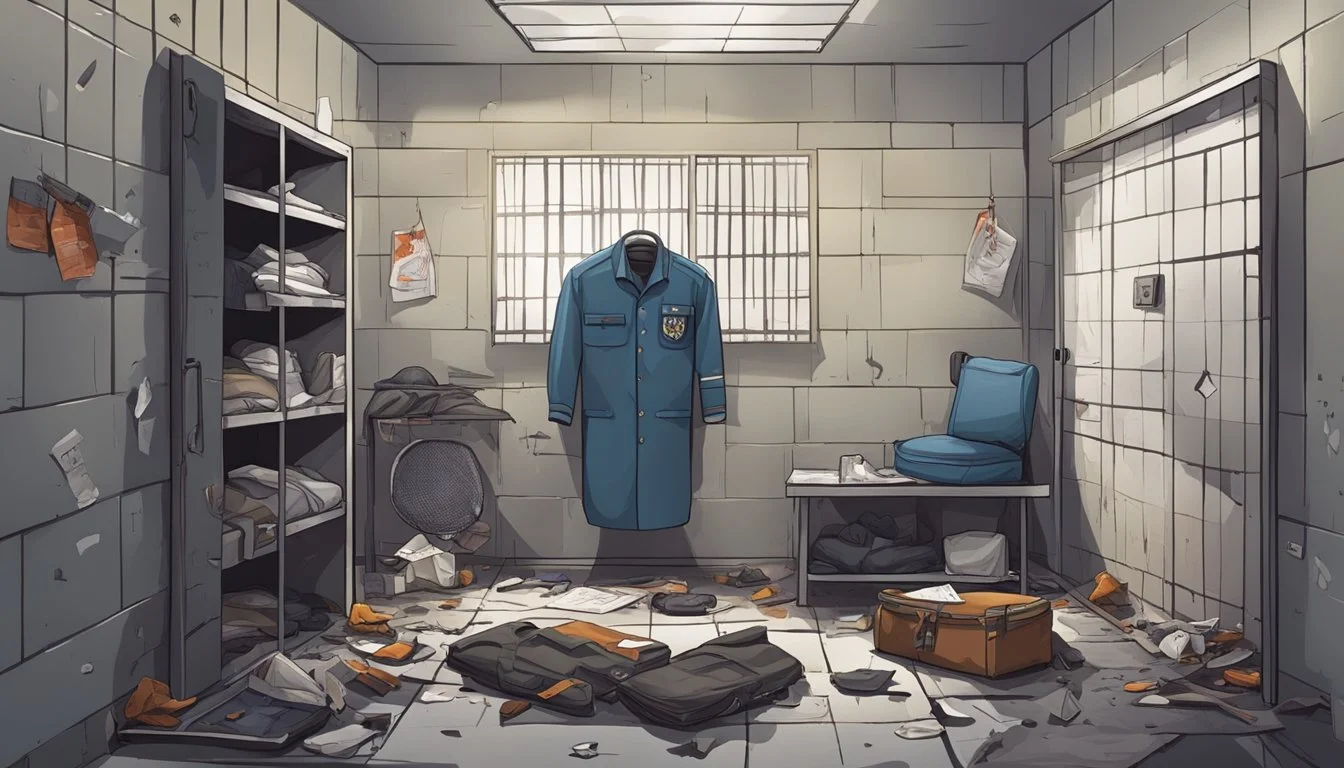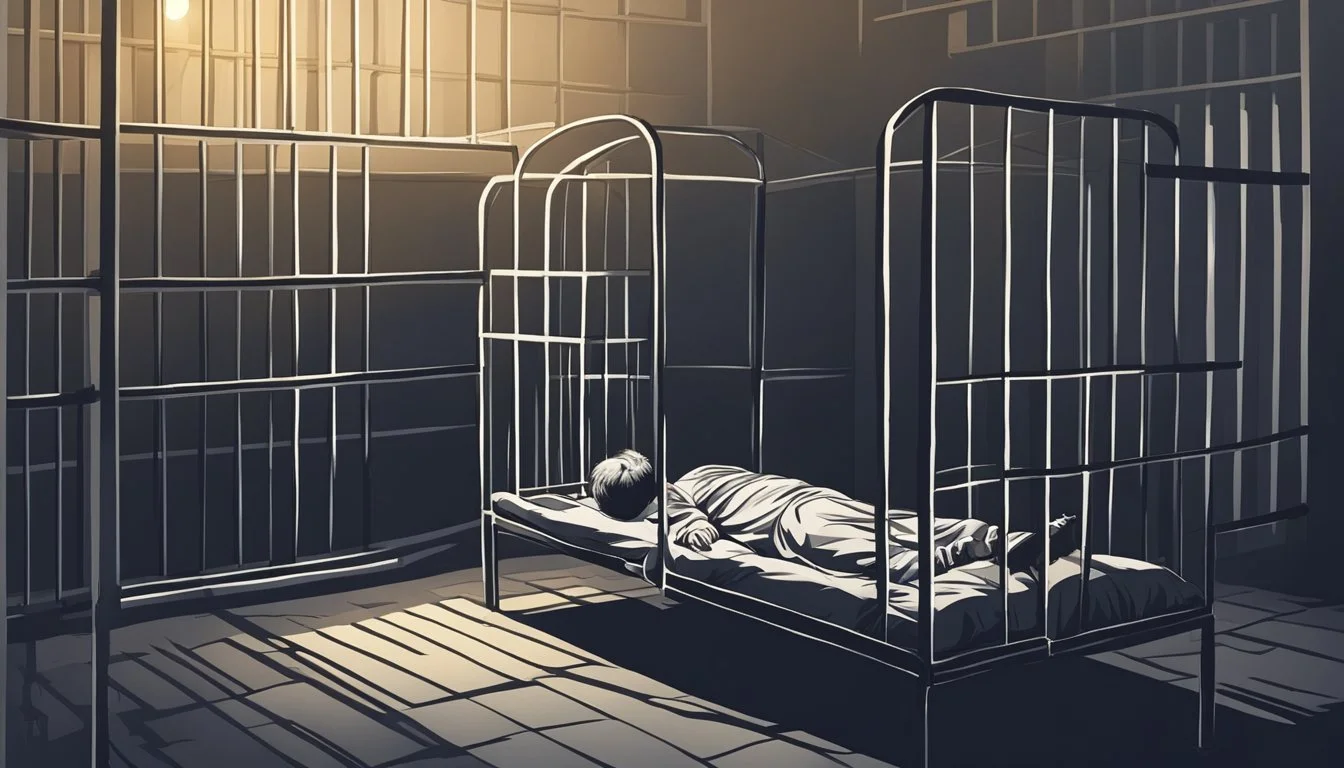Gerard Schaefer's Final Tarnish: Killer Cop's Violent Prison Passing
Ex-Officer Meets Grim End Behind Bars
Gerard Schaefer, the notorious "Killer Cop" from Florida, met a violent end behind bars on December 3, 1995. A former deputy sheriff turned convicted murderer, Schaefer's death at the hands of a fellow inmate brought closure to a dark chapter in criminal history.
Schaefer's reign of terror included the brutal murders of at least two teenage girls, with suspicions of up to 30 additional victims. His crimes shocked the nation, exposing a disturbing case of law enforcement corruption in the 1970s. Schaefer exploited his badge to prey on vulnerable victims, leaving a trail of devastation in his wake.
During his time in prison, Schaefer continued to torment victims' families through threatening letters. This behavior led to increased restrictions on his privileges. Ultimately, his life of violence ended as it began - with a brutal act that silenced the man known as the "Butcher of Blind Creek" forever.
Gerard Schaefer: From Law Enforcement to Lawbreaker
Gerard John Schaefer Jr. began his career in law enforcement in Florida during the late 1960s. He served as a police officer in Wilton Manors and later as a deputy sheriff in Martin County.
Despite his role as a protector of the public, Schaefer harbored dark impulses. His transition from law enforcer to lawbreaker shocked the community and his colleagues.
In 1972, Schaefer's criminal activities came to light. He was arrested for kidnapping and assaulting two teenage girls while on duty as a deputy sheriff.
This incident marked the beginning of the unraveling of Schaefer's double life. Investigators soon uncovered evidence linking him to multiple murders.
Schaefer's crimes were particularly heinous, involving abduction, torture, and mutilation. His victims were primarily young women and girls.
The case gained national attention, earning Schaefer notorious nicknames like "Killer Cop" and "the Hangman."
In 1973, Schaefer was convicted for the murders of Susan Place and Georgia Jessup, two teenage girls from Broward County, Florida.
Authorities suspected Schaefer of up to 30 additional murders, though the exact number remains unknown.
Schaefer's fall from law enforcement officer to convicted killer highlighted the devastating betrayal of public trust. His case serves as a chilling reminder that sometimes, the protectors can become the predators.
The Psyche of a Killer
Gerard Schaefer's mental state revealed a complex mix of pathological traits and deviant behaviors. His psychological profile offers insights into the mind of a serial killer, while comparisons to other notorious murderers highlight both commonalities and unique aspects.
Profile and Psychiatry
Schaefer claimed to have sought psychiatric help in 1966 for sexual deviance and homicidal fantasies. This early recognition of his disturbing thoughts suggests a level of self-awareness, though therapy proved ineffective in curbing his violent impulses.
Psychiatrists who evaluated Schaefer noted several key traits:
Antisocial personality disorder
Sadistic tendencies
Narcissistic traits
Lack of empathy
These characteristics aligned with typical profiles of serial killers. Schaefer's ability to maintain a façade of normalcy as a law enforcement officer while harboring violent urges demonstrated his capacity for deception and compartmentalization.
Comparative Analysis with Other Killers
Schaefer shared certain traits with other notorious serial killers, particularly Ted Bundy. Both men:
Appeared outwardly charming and normal
Targeted young women
Used their positions of authority to gain trust
However, Schaefer differed in his post-capture behavior. Unlike Bundy's public persona, Schaefer harassed victims' families through letters and made threats against witnesses from prison.
Comparisons to Ottis Toole reveal contrasts in background and methodology. While both were convicted killers, Toole's crimes often involved his partner Henry Lee Lucas, whereas Schaefer typically acted alone.
Timeline of Terror
Gerard Schaefer's reign of terror unfolded over several years, marked by escalating violence and a growing list of victims. His transition from law enforcement to serial killer shocked the community and left a trail of devastation.
Rise of a Serial Killer
Gerard John Schaefer Jr. was born on March 26, 1946, in Wisconsin. As a child, he exhibited troubling behavior and struggled with violent fantasies. In 1966, Schaefer sought psychiatric help for his deviant urges, but treatment proved ineffective.
Schaefer's criminal activities began in earnest during the early 1970s. He joined the Martin County Sheriff's Office in Florida, using his position to prey on vulnerable individuals.
His first known crimes occurred while on duty, setting a pattern for future attacks.
Hitchhiking Horrors
Schaefer targeted young women, often those hitchhiking or traveling alone. In July 1972, he abducted two teenage girls while on patrol. He took them to a remote area, intending to assault and murder them.
Miraculously, the girls escaped and reported the incident. Schaefer was arrested but released on bond. This close call did not deter him from continuing his spree.
He refined his tactics, becoming more cautious in selecting and approaching victims. Schaefer's attacks grew increasingly brutal and sophisticated.
Stalking and Torture
Schaefer's modus operandi involved extensive stalking of potential victims. He meticulously planned his attacks, often observing targets for days or weeks.
Once he abducted a victim, Schaefer subjected them to extreme torture. He used various tools and methods to inflict pain, deriving sadistic pleasure from their suffering.
Many of his victims were never found, their fates known only to Schaefer. Those bodies recovered showed signs of mutilation and sexual assault.
Schaefer's reign of terror lasted until his arrest in 1973 for the murders of Susan Place and Georgia Jessup.
The Arrest and Conviction
Gerard Schaefer's reign of terror came to an end in 1972 when law enforcement finally caught up with him. His capture, trial, and conviction marked a significant turning point in the case.
Capture and Charges
In July 1972, Schaefer kidnapped two teenage girls, Nancy Trotter and Pamela Wells. The girls managed to escape and reported the incident to the police. This led to Schaefer's arrest on July 21, 1972. He was charged with false imprisonment and assault with intent to commit murder.
While out on bond, Schaefer committed the murders of Susan Place and Georgia Jessup in September 1972. Their disappearance prompted an investigation that eventually linked Schaefer to the crime.
Legal Proceedings
The trial began in October 1973. Prosecutors presented damning evidence, including personal writings and sketches found in Schaefer's home. These detailed his violent fantasies and crimes.
Key testimony came from Schaefer's wife, who discovered incriminating evidence in their home. Forensic experts also provided crucial testimony linking Schaefer to the murders.
The defense attempted to portray Schaefer as mentally unstable, but this strategy ultimately failed.
First-Degree Murder Convictions
On October 4, 1973, the jury found Gerard Schaefer guilty of two counts of first-degree murder for the killings of Susan Place and Georgia Jessup. The trial lasted just over a week.
Judge C. Pfeiffer Trowbridge sentenced Schaefer to two life terms in prison, to be served consecutively. The judge noted the heinous nature of the crimes in his sentencing remarks.
Schaefer maintained his innocence throughout the trial and after his conviction. However, the evidence against him was overwhelming.
Incarceration and Inmate Interactions
Gerard Schaefer's time in prison was marked by tension and conflict. His status as a former law enforcement officer and the nature of his crimes shaped his interactions with other inmates.
Life in Prison
Schaefer was incarcerated at Florida State Prison following his conviction in 1973. He faced strict security measures due to the severity of his crimes. Daily routines included confined cell time and limited supervised activities.
Schaefer maintained his innocence throughout his imprisonment. He wrote extensively, including a book of short stories that drew controversy for their violent content. Prison officials monitored his communications closely.
His background as a former deputy sheriff set him apart from other inmates. This distinction likely contributed to heightened scrutiny from both prison staff and fellow prisoners.
Prisoner Relations
Schaefer's interactions with other inmates were complex and often hostile. His status as an ex-law enforcement officer made him a target for violence. Many prisoners viewed him with suspicion and animosity.
He reportedly faced threats and physical altercations. Schaefer's claims of innocence and attempts to present himself as wrongfully convicted did little to improve his standing among the prison population.
Some accounts suggest Schaefer tried to manipulate other inmates, leveraging his former position. This behavior further strained his relationships within the prison community.
The Grim End: Schaefer's Violent Demise
Gerard John Schaefer's life of crime came to an abrupt and brutal end on December 3, 1995. The former deputy sheriff turned convicted murderer met his fate within the confines of the Florida State Prison.
Schaefer, who had been serving two life sentences for the murders of Georgia Jessup and Susan Place, was found dead in his cell. The cause of death was determined to be multiple stab wounds.
A fellow inmate was responsible for Schaefer's murder. The attack occurred in the prison's general population area, where Schaefer had been housed for years.
The violent nature of Schaefer's death mirrored the brutality of his own crimes. Many viewed his demise as a form of poetic justice for the heinous acts he had committed.
Schaefer's passing marked the end of a dark chapter in Florida's criminal history. His death at the age of 49 closed the book on any possibility of further revelations about his suspected additional victims.
The prison murder effectively silenced Schaefer, preventing him from ever fully disclosing the extent of his crimes. This left many cold cases potentially unsolved and families without closure.
Aftermath and Legacy
Gerard Schaefer's crimes left a lasting impact on victims' families, true crime narratives, and legal reforms. His case continues to be studied and discussed decades later.
Impact on Victims' Families
Schaefer's murders devastated numerous families. Many victims' loved ones never found closure, as some bodies were never recovered. The trauma of losing children and siblings to such brutal violence had long-lasting psychological effects.
Support groups formed to help families cope with their grief and anger. Some relatives became advocates for victim's rights and pushed for stronger laws to protect potential targets of violent crime.
True Crime Narratives and Media Portrayal
Schaefer's case became a subject of true crime books and documentaries. Author Sondra London, who corresponded with Schaefer, published his writings and drawings, sparking controversy.
Hollywood adaptations fictionalized aspects of the case, drawing criticism for sensationalizing the crimes. Some portrayals were accused of glorifying Schaefer rather than focusing on the victims.
Media coverage raised awareness about serial killers operating within law enforcement, leading to increased scrutiny of police hiring practices.
Lessons Learned and Legal Reforms
Schaefer's crimes exposed weaknesses in background checks for law enforcement officers. Many agencies implemented more rigorous screening processes and psychological evaluations for applicants.
The case contributed to the passage of the Driver's Privacy Protection Act, restricting access to personal information through DMV records. This law aimed to prevent criminals from using such data to target victims.
California's anti-stalking law (Penal Code 646.9) was influenced by cases like Schaefer's, recognizing the need to address predatory behavior before it escalates to violence.
Law enforcement agencies improved training on identifying potential serial offenders and handling missing persons cases more effectively.
Comparative Criminal Behavior
Gerard Schaefer's crimes and methods shared similarities with other notorious killers, while also influencing future offenders. His case provides insights into patterns of serial murder and the psychology of predatory criminals.
Schaefer vs. Bundy
Gerard Schaefer and Ted Bundy operated in Florida during overlapping time periods, targeting young women. Both used their charisma and positions of authority to lure victims. Schaefer exploited his role as a police officer, while Bundy often pretended to be injured or in need of assistance.
Their crime scenes differed significantly. Schaefer favored remote outdoor locations and employed elaborate bondage techniques. Bundy, in contrast, often attacked in residential settings and relied more on blunt force trauma.
Psychologically, Schaefer displayed more sadistic tendencies, keeping "trophy" items and detailed journals. Bundy maintained a façade of normalcy and charm, even while incarcerated.
Influence on Other Criminals
Schaefer's writings from prison reportedly inspired other offenders. Robert John Bardo, convicted of murdering actress Rebecca Schaeffer, corresponded with Schaefer and cited him as an influence.
Ottis Toole, linked to the Adam Walsh case, claimed to have known Schaefer. While unverified, this connection highlights the network of communication among violent offenders.
Schaefer's methods of using his badge to gain trust became a cautionary tale in law enforcement circles. His case led to increased scrutiny of police officer backgrounds and psychological evaluations.
The detailed nature of Schaefer's crimes and his willingness to discuss them provided researchers with valuable data on serial killer psychology and behavior patterns.
The Role of Location in Schaefer's Crimes
Gerard Schaefer's criminal activities were deeply intertwined with the locations he chose. His familiarity with Florida's landscape played a crucial role in his ability to carry out and conceal his crimes.
Florida's Dark History
Florida's dense forests and secluded areas provided Schaefer with ideal locations to commit his heinous acts. The state's humid climate and abundant wildlife accelerated decomposition, making it challenging for investigators to recover evidence.
Schaefer exploited Florida's transient population and tourism industry. Many of his victims were out-of-state visitors or runaways, making their disappearances less likely to raise immediate alarms.
The Sunshine State's reputation as a vacation destination also worked in Schaefer's favor. People were more likely to let their guard down, creating opportunities for him to target unsuspecting victims.
Schaefer's Hunting Grounds
Schaefer's knowledge of local terrain, gained through his work as a deputy sheriff, gave him a significant advantage. He frequented isolated beaches, wooded areas, and less-traveled roads to find victims and dispose of bodies.
Port St. Lucie and Fort Lauderdale were key locations in Schaefer's criminal activities. These areas had rapidly growing populations in the 1970s, providing a steady stream of potential victims.
Schaefer also traveled to Tucson, Arizona, and Eugene, Oregon, expanding his hunting grounds beyond Florida's borders. These out-of-state trips allowed him to evade local law enforcement and potentially commit crimes in jurisdictions unfamiliar with his modus operandi.
Reflecting on Gerard Schaefer's Crimes
Gerard Schaefer's brutal acts left a lasting impact on victims' families, law enforcement, and the broader public. His case prompted deeper examination of criminal psychology and the portrayal of serial killers in media and literature.
The Psychological Aftermath
Psychiatrists studied Schaefer's case to gain insights into the mindset of serial killers. His background as a law enforcement officer added a disturbing layer to the psychological analysis. Experts sought to understand how someone sworn to protect could become a predator.
The impact on survivors and victims' families was profound. Many struggled with trauma and sought professional help to cope. Support groups formed, providing a network for those affected by Schaefer's crimes.
Law enforcement agencies reassessed their hiring and screening processes. Schaefer's case highlighted the need for more rigorous psychological evaluations of police candidates.
The Role of Literature in Understanding Serial Killers
Sondra London, Schaefer's ex-fiancée, published his writings after his conviction. This controversial move sparked debate about the ethics of giving voice to killers through literature. Some argued it provided valuable insights, while others saw it as glorifying his crimes.
True crime authors used Schaefer's case as source material. Books like "Scenes From the Class Struggle in Beverly Hills" referenced his crimes, reflecting society's fascination with serial killers. These works aimed to analyze criminal psychology and societal factors contributing to such behavior.
Academics studied Schaefer's writings to better understand the criminal mind. This literary analysis became a tool for criminologists and psychologists seeking to prevent future crimes.









